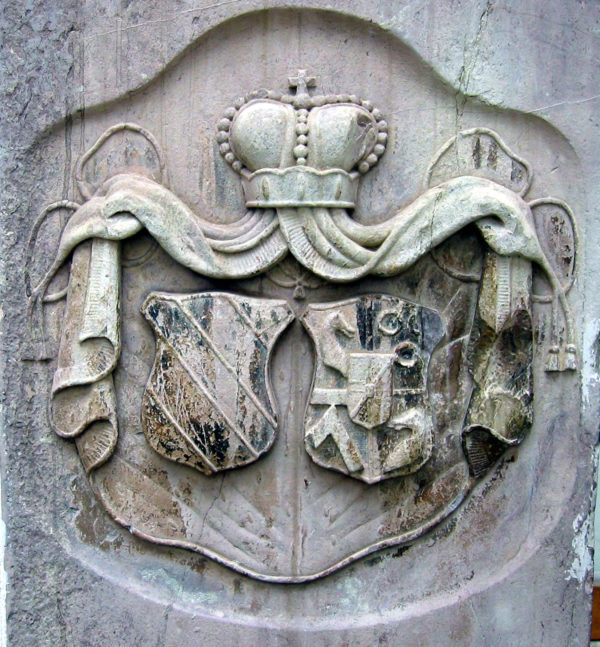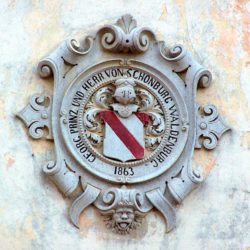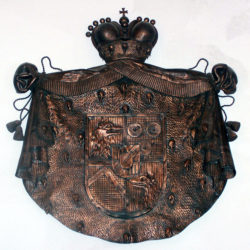
Arms of alliance of the Schönburg and Windisch-Graetz families in Podsreda Castle
PODSREDA, CASTLE
Location of the coat of arms: other
The last private owners of Podsreda Castle (Hörberg) between 1848 and the Second World War were the Princes von Windisch-Graetz. In the year of the March Revolution, Weriand Prince von Windisch-Graetz (1790–1867) purchased the castle from the Barons Lazarini. Podsreda was only one of the many estates in modern Slovenia that Prince Weriand purchased in the mid-nineteenth century.
The memory of the period during which the Windisch-Graetzes ruled over Podsreda is still kept alive by the arms of alliance, carved in the newel post of the staircase in the castle courtyard. They symbolize the marriage of Weriand’s daughter Gabriela Princess von Windisch-Graetz (1824–1917) and Friedrich Count von Schönburg-Glauchau (1823–1897), who lived in the castle for a while. Gabriela was the only daughter produced by the union of Prince Weriand and Eleonora Princess von Lobkowicz. She had two older and two younger brothers.
Gabriela Windisch-Graetz and Friedrich Schönburg-Glauchau married in 1852 in Prague. The groom was a representative of an old Franco-Thuringian noble family. The Schönburgs had the center of their estates in Saxony, where they came very close to establishing a state within the state, but ultimately renounced further attempts to do so in 1740 to the benefit of the prince-elector of Saxony. Already in the sixteenth century, the family split into the so-called upper line, which was raised to the rank of princes in 1790 and is currently divided into the Schönburg-Waldenburg and Schönburg-Hartenstein lines, and the so-called lower line, which was elevated to the rank of counts in 1700, retaining the same status to the present day. This line, too, split several times, producing the Schönburg-Hinterglauchau and Schönburg-Forderglauchau branches in the second half of the nineteenth century. Friedrich, who resided for a while at Podsreda, was a representative of the Schönburg-Hinterglauchau branch, which became extinct in its male line in 1900, after he and his younger brother Reichard Clemens (1829–1900) died without issue.
When his only daughter married Friedrich Schönburg-Glauchau, his father-in-law, Weriand Prince von Windisch-Graetz, gifted the newlyweds Podsreda Castle, in which they resided for several years. During that period, Friedrich substantially rearranged and embellished the castle building. He expanded the courtyard, added a high escarpment to it, encircled it with a wall with superstructures, and closed it with two large entrances. In memory of the construction work done, he had the arms of alliance of his and his wife’s families carved in the newel of the courtyard staircase. In this connection, there are two points of interest that deserve mention. First, the Schönburg coat of arms has remained unchanged ever since the twelfth century. It is a very simple coat of arms, typical of old medieval families. The Schönburgs (the entire family, regardless of all the divisions) prided themselves on the simplicity of their arms, which symbolized their ancient origin. Second, the Schönburg coat of arms in Podsreda is heraldically wrong by being divided into four rather than three fields. The mistake was probably made by the stonemason because it is very unlikely that Count Schönburg himself would have commissioned a wrong form of arms.
Count Schönburg was well liked among the residents of Podsreda, who made a good living in his service, and he also frequently donated money to children in the surrounding areas. Being childless himself was perhaps the reason why he decided to move out of spacious Podsreda Castle in 1857. He spent the final years of his life in Graz, where he died in 1897. His widow Gabriela survived him by twenty years, dying in 1917.
Sources:
Stekl, Hannes & Wakounig, Maria: Windisch-Graetz: ein Fürstenhaus im 19. und 20. Jahrhundert. Wien, Köln, Weimar: Böhlau, 1992, p. 301.
Stopar, Ivan: Grad Podsreda. Med včeraj, danes in jutri. Celje: Zavod za varstvo naravne in kulturne dediščine Celje, 1999.
Stopar, Ivan: Grajske stavbe v vzhodni Sloveniji. Knj. 5, Med Kozjanskim in porečjem Save. Ljubljana: Viharnik, 1993, pp. 79–92.
Windisch-Graetz, Hugo-Vinzenz: Unsere Familiengeschichte. Selbstverlag, 1959, pp. 152–154.


